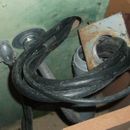Bending big feeder wires into outdoor pedestal
30 or so years ago, the pedestal in the attached photo provided power to a manufactured home, long gone now, through three 3/0 wires and a smaller ground that came out of the pedestal into the rusty box, where they made a 90-degree turn into the vertical 2″ conduit below. Now, I have the three 4/0 XHHW-2 wires and a smaller ground in the photo connected to a panel inside my stick-built house, but I’m finding it surprisingly difficult to get them into the pedestal. I’ve pushed roughly 6″ into the pedestal, but that’s as far as they want to go, either as a group or individually. It feels as if they’re hitting something inside the pedestal, but they’re not; they’re just resisting the necessary bending. Once I get them pushed all the way into the pedestal, the rusty box will be ready to reattach to the pedestal and conduit, as the wires run through a male adapter and lock ring, both inside the box, which can slide up and down the wires as needed while pushing them in.
I stopped struggling with it yesterday in the hope that I would realize I was doing something stupid and approach it with a better idea today, but sometimes better ideas have to come from other minds. Any suggestions?
GBA Detail Library
A collection of one thousand construction details organized by climate and house part










Replies
In case anyone runs into a similar situation, here's how I got it done. It took around 3 hours. I shifted the angle of the wires with respect to the hole they had to go through till I found the angle they liked best for pulling one wire at a time as far as it would go, usually just a couple of inches. Pulling them in a certain order each time seemed to make a significant difference. After each pull, I would give each wire a little push. Pulling and pushing each wire a couple of inches at a time worked well until the last 8 inches or so, when the progress slowed to perhaps half an inch. I did manage to avoid any small-radius bends, and I taped the edges of the hole to protect the wires' insulation, so after an amazingly tedious effort, the result was good. If you are reading this in anticipation of dealing with a pedestal like mine, you may want to consider copper wire, which will allow you to use a smaller size that should be easier to pull through conduit as well as to get into your pedestal.
You need a bushing in that knockout hole. I would use a chase nipple and plastic bushing here. You're not supposed to stress the wires against a sharp edge like that since you risk cutting through the insulation over time.
Klein Tools makes a cable bending tool for this sort of application:
https://www.amazon.com/Bender-12-Inch-Klein-Tools-50400/dp/B000OMLVZM/ref=sr_1_2?crid=1ACBI6RT97JKN&dib=eyJ2IjoiMSJ9.M4J6pyU7e9RTUYeMVgeQZM7r52BQ-HBlee6FYAiin-YY99NyN2ciWoLUVEARXSTeGNBZvdziiZKBvfXjuy8wQyODsgzANCCPNU5KUTSCu3avnPOULNu4O3woB98a760c0BXFBFF0_koYAsuieJHUEo9CMfF72eWU-MGV4eFsVLudlrscrvL6eIluvWHfjH7Sa62GtHwamGgA5VIRMegPZS6UTEsyGPOs0abmFxyLd9lY0PvG8NA3HvpBnsJLvCmDateWJXhAPVmLA87HKR5sfr1B1z1nf4LoWq64MBShsfk.zzY-9TCQCYvTOYD50Mp5F8SoWRFKwiZWBsjH0fc3TDg&dib_tag=se&keywords=klein+wire+bender&qid=1726488305&sprefix=klein+wire+b%2Caps%2C113&sr=8-2
For even larger cables, I have used conduit benders in the past (although you probably don't have the room for that here). I also try to pre-bend the wires as much as possible prior to putting them around the actual bend in the box.
Bill
Thank you, Bill. I did install a bushing there, but it had to wait till the wires were through the hole. I used thick duct tape to cover the edges of the hole while I was getting the wires through.
Commercial electrical fabricators use a product known as "edge guard" here:
https://www.amazon.com/Edge-Trim-Black-Small-Fits/dp/B00M8MAOLI/ref=sr_1_1?crid=H8INMOKYVZG3&dib=eyJ2IjoiMSJ9.Ud1HZs0sEAa9C5c8JdFWitiYWAc6qTEWI2tXSmmd8B8l8PU8P3YtLpEQcO3c0Ii5AvO6v4LHUvYMVov76mSqPzBRXl4DTvNCfcn0BejlIFYPAyUmi8wWhcxxjzcAq08WWqWeriRqyjJW129V8dIO9sB2uyzLYQpeYrtwiuHAgONfJeXUDB06IACJXaisqMrB1_TSB9JVOsMoY6ktTSZmMW9w8Juknrzk9SxM9dGNCKwhkNGoyvZu2-86RmTECQVFtDsqBqM2_6JMaoimur2D1jt8D3mKwAHFIHVixyJPG18.1LA42wx-3i8VjsA6ZmYQc774VpBY4Fc-tTni4OTwNmY&dib_tag=se&keywords=edge%2Bguard%2Bnylon&qid=1726497710&sprefix=edge%2Bguard%2Bnylo%2Caps%2C128&sr=8-1&th=1
That's one variation. There is also a nylon style that has "fingers" on the edges so it's easier to conform to rounded shapes. Both styles can do better than duct tape in this type of application :-)
Bill